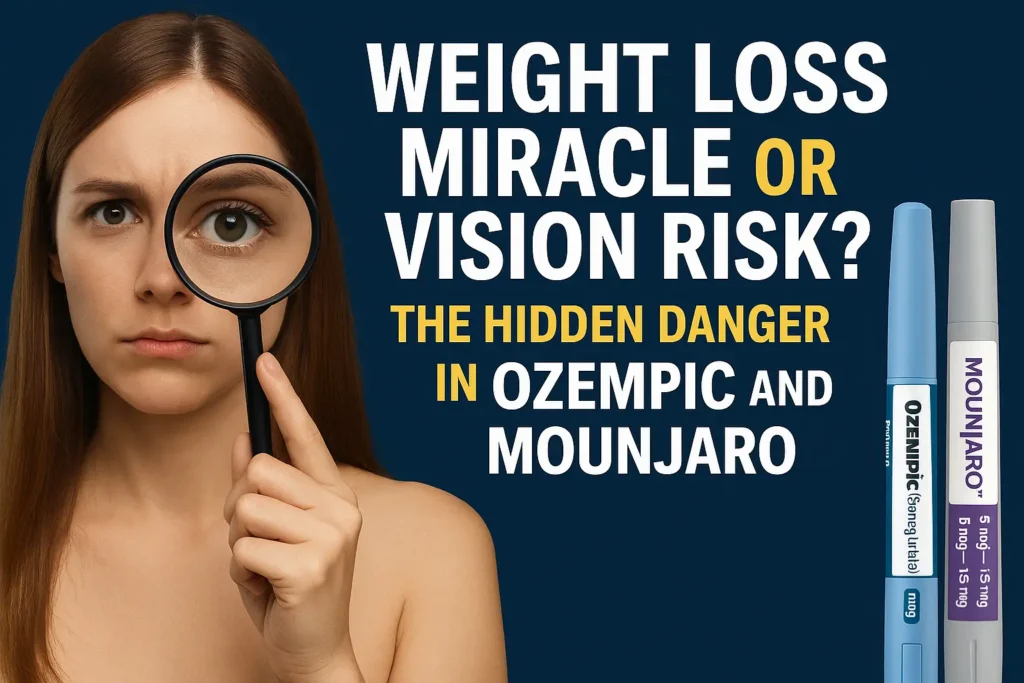Weight Loss Miracle or Vision Risk? The Hidden Danger in Ozempic and Mounjaro

By NewzSquare Health Desk | Updated June 17, 2025
Recent findings highlight a concerning potential link between commonly prescribed GLP‑1 receptor agonists (GLP‑1 RAs) including semaglutide (Ozempic, Wegovy) and tirzepatide (Mounjaro, Zepbound) and an increased risk of developing neovascular (wet) age-related macular degeneration (nAMD), a serious eye condition that can lead to rapid vision loss and even blindness.
Table of Contents
What Are GLP‑1 Drugs?
GLP‑1 RAs are injectable medications originally developed to manage type 2 diabetes. These drugs mimic the hormone glucagon-like peptide‑1, which regulates blood sugar, suppresses appetite, and supports weight loss. In recent years, semaglutide and tirzepatide have also been widely prescribed off-label for obesity, in addition to their FDA-approved uses in diabetes and weight management.
New Study Reveals Elevated Risk of Wet AMD
A large-scale observational study in Ontario, Canada (2020–2023) examined over 139,000 patients with type 2 diabetes, averaging 66 years of age, who had used a GLP‑1 medication for at least six months.
Key findings:
- GLP‑1 users had more than double the risk of developing nAMD compared to non-users (0.2% vs. 0.1% annual incidence).
- Long-term users (30+ months) had a threefold increased risk.
- Semaglutide accounted for 97.5% of all GLP‑1 prescriptions in the study, while tirzepatide’s impact remains under further investigation.
While the absolute risk remains low, the relative increase is significant, especially for older adults and individuals with a history of stroke or retinal disease.
Other Eye Conditions Also Linked to GLP‑1s
Previous reports and smaller studies have connected GLP‑1 drugs with other vision-related complications, including:
- Non-arteritic anterior ischemic optic neuropathy (NAION) – sometimes described as an “optic nerve stroke.”
- Papillitis and paracentral acute middle maculopathy – reported in a small case series of nine patients.
- Worsening diabetic retinopathy – noted in earlier clinical trials (e.g., SUSTAIN‑6) involving semaglutide.
These conditions may be exacerbated by rapid glycemic shifts caused by GLP‑1 therapy, potentially disrupting delicate blood vessels in the retina.
What Mechanisms Might Explain the Link?
Researchers suggest several mechanisms behind these visual side effects:
- Rapid blood sugar reduction can alter fluid dynamics in the eye, stressing the retinal microvasculature.
- GLP‑1 receptors are present in retinal tissue, indicating the possibility of direct drug effects on eye blood vessels.
- Surveillance bias may also play a role patients on GLP‑1s often receive closer medical follow-up, increasing the likelihood of diagnosis.
Expert Guidance: Stay Vigilant, Not Alarmed
Medical experts emphasize that GLP‑1 drugs still offer major benefits particularly for cardiovascular, metabolic, and kidney health. However, they recommend caution, particularly for patients with existing eye conditions or risk factors.
Recommended steps:
- Schedule a baseline eye exam before starting GLP‑1 treatment.
- Undergo routine retinal monitoring, especially after six months or during long-term use.
- Use tools like the Amsler grid to self-monitor for changes such as wavy lines or blurriness.
- Seek immediate medical attention if experiencing sudden vision changes.
Dr. Reut Shor of the University of Toronto emphasized:
“While the absolute risk remains low, this represents a relative doubling clinically meaningful for older adults.”
Regulatory Perspective: Monitoring in Progress
- Australia’s Therapeutic Goods Administration (TGA) reported over 40 vision-related events, including two cases of sudden blindness.
- Novo Nordisk, maker of Ozempic and Wegovy, stated that no direct causal link has been confirmed in clinical trials but that post-market monitoring is ongoing.
- The UK’s Medicines and Healthcare products Regulatory Agency (MHRA) has not officially listed AMD as a side effect but is reviewing new evidence.
What Patients Should Do Now
If you are using or considering a GLP‑1 medication:
- Do not stop the medication without consulting your healthcare provider.
- Schedule an eye exam within the first 3–6 months of treatment.
- Self-monitor weekly for vision changes using basic eye checks.
- Report any symptoms such as central blurriness, wavy lines, or sudden loss of vision immediately.
Those over 65, or with a history of stroke, diabetic eye disease, or rapid weight loss, should be particularly careful.
What Research Experts Are Calling For
Ongoing and future research should focus on:
- Longer-term studies across different demographics.
- Use of retinal imaging tools (e.g., OCT/OCTA) to detect subtle changes.
- Drug-specific analysis to distinguish effects of semaglutide vs. tirzepatide.
- Exploration of dose-response effects and interactions with preexisting eye disease.
Bottom Line
GLP‑1 drugs remain a valuable treatment option for diabetes and obesity.
However, recent studies raise valid concerns about a low but meaningful increase in the risk of serious eye conditions like nAMD.
Patients and healthcare providers should remain informed, vigilant, and proactive about eye health monitoring.
Sources: nypost.com, dailytelegraph.com.au, indiatimes.com








